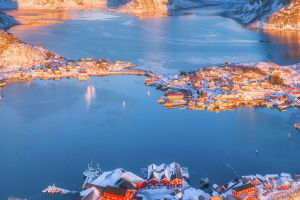Even people who don't know about Salt Lake must have heard the name "Mirror of the Sky". In 2009, Japan's NHK TV went to South America to film the documentary "A Journey to Uyuni, Bolivia, South America", which was named after the Salar de Uyuni in Bolivia for the first time. Since then this beautiful name has spread widely in Asia.
Although Uyuni is already the pinnacle of salt flats, the world is so big, and every beauty is actually different. Let’s take a look at other salt lakes that make you yearn.
1. Badwater Basin, Death Valley, California
Badwater Basin is located in Death Valley National Park, California. The altitude here is -86 meters, which is the lowest point in North America, and there may be ultra-high temperatures of 50 degrees Celsius in summer. Therefore, even if there is rainfall, it can only continue to evaporate and cycle.
Repeatedly, the salt forms hexagonal honeycomb crystals on the surface. The salt flats here give people a desolate feeling. The protruding salt crystals are like uneven scars on the ground, as if the villains in Disney movies will appear at any time, which is very beautiful in a unique way.
2. Etosha Pan, Namibia
Etosha, which means huge white land in the Owanan language, is about 130 kilometers long and 50 kilometers wide and occupies about a quarter of Namibia's Etosha National Park. Looking down from the sky, the Etosha salt flats are like a piece of white jade scattered in the world, crystal clear and pure.
The salt flat area itself contains high salinity, lacks water, and no grass grows. During the rainy season when the rainfall is extremely high, the Etosha salt flats can store about 10 cm of lake water, and flocks of white pelicans and flamingos will come to forage. Most of the wild animals are distributed in the grasslands around the salt flats, or gather near water holes. African elephants love to be close to the salt flats. These spiritual creatures like to roll on the salty mud and make themselves white, so they are called "Etosha White Elephant" or "Etosha Ghost".
3. Bonneville Salt Flats, Utah
It's not surprising that Utah has salt marshes, after all, its capital is called Salt Lake City, and the entire city is named after the Great Salt Lake. With an area of approximately 3,525 square kilometers, the Great Salt Lake is the largest saltwater lake in the Western Hemisphere.
In 1959, a railway was built over the Great Salt Lake, dividing it in two, and the northern lake turned pink because of the different minerals it contained. Influenced by changes in rainfall and river water recharge, the area of the Great Salt Lake has also changed continuously.
In 1872, the Great Salt Lake was 6,200 square kilometers, while in 1963 it was only 2,460 square kilometers. The 260-square-kilometer Bonneville Salt Flats are just west of the Great Salt Lake and are part of the dried-up Great Salt Lake.
Of course, there is also the mirror of the sky here. It is quiet and empty, and there are several distant mountains dotted on the horizon. Many American couples come here to take couple photos and wedding photos.
4. Salinas Grandes, Argentina
The Salina de la Grandes is located in north-central Argentina, spanning four provinces, with an area of about 4,700 square kilometers and an average elevation of over 4,500 meters. Because the original ecology has not been developed, the main use of this salt marsh is still mining salt mines, which looks extraordinarily clean.
After the salt bricks were dug away, there were pools left on the ground, with a pool of green water, which is the exclusive feature of this place. The water quality here is excellent, and there are occasionally natural water holes or ponds on the salt flats. The jelly-colored ones can be seen to the end at a glance.
If it weren't for the salt in the water and the high altitude, it is estimated that many people would not be able to help jumping down and having fun.
5. Chottel Jerid, Tunisia
The Jared Great Salt Lake is located in the Sahara Desert in the south of Tunisia, with a surface area of 7,000 square kilometers. It is the third largest salt lake in the world and the largest desert salt lake in the world. The Jared Great Salt Lake, surrounded by desert, receives only 100 mm of annual precipitation, but it can reach as high as 50 degrees Celsius.
Extreme weather brings extreme weather anomalies, and mirages are common here. In the rainy years, the Great Salt Lake of Jared will also become a vast lake, which can be crossed by boat. In summer, the lake dries up, and the crossed canoes are also stranded on the desert, becoming a popular check-in place for tourists.
The reddish-brown salt flats are so vast in summer that they look alien. The Star Wars series was filmed here, and Shmi Skywalker is buried here.


